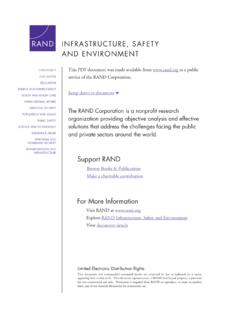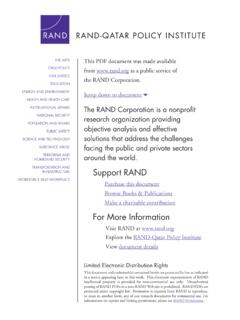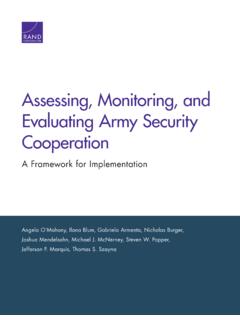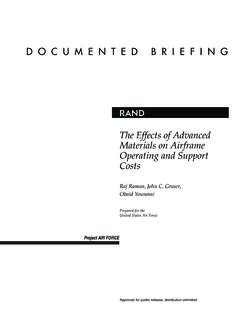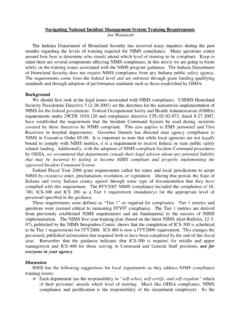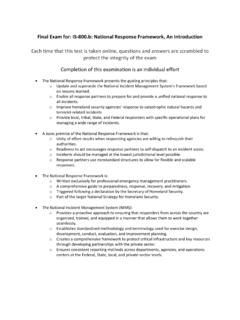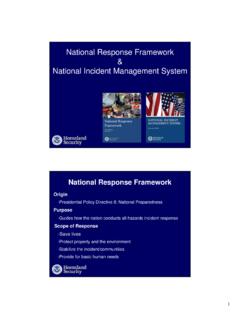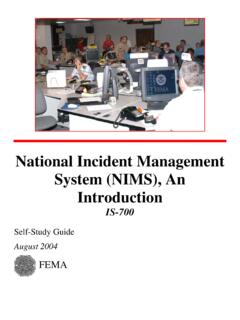Transcription of National Response Plan/ National Incident …
1 National Response Plan/ National Incident management SystemBriefing for Gilmore CommissionJune 16-17, 2003 What Does HSPD-5 Require? To prevent, prepare for, respond to, and recover from terrorist attacks, major disasters, and other emergencies, the United States Government shall establish a single, comprehensive approach to domestic Incident management . The objective of the United States Government is to ensure that all levels of government across the nation have the capability to work efficiently and effectively together using a National approach to domestic Incident management . February 2003 HSPD-5 Deliverables June 1 - NRP Initial Plan distributed July 1 - Initial NIMS distributed August 1 - Comments/Agencies revise existing plans September 1 Comments/Agencies provide strategies to implement NIMS September 1 - Secretary reviews authorities and provides recommendations to the President TBD-NRP and NIMS ImplementationPOTUSHSCSECDHSG uidanceTeamWork TeamDHS OfficesOthersRANDF ederal AgenciesStatesLocalPrivate SectorPublicNRP/NIMS Development Process Introduction Mandate for Change Purpose of the NRP Scope of the NRP Applicability Planning Assumptions & Considerations Design Imperatives Guiding Principles Life-Cycle of Incident management Activities Awareness Prevention Preparedness Response Recovery Organization of the NRP Roles and Responsibilities State & Local Government Federal Government Private Sector Citizenry Concept of Operations
2 Overview Interim Implementation Guidelines Primary Federal Agency Assignments Concept for Specific Contingencies Preliminary NIMS Framework Plan for Full Development & Implementation Remaining Tasks Additional Guidance Long-Term Guidance AnnexesNRP Table of ContentsWhat s the Goal? Single comprehensive plan New base plan - not umbrella plan National not just Federal Merges crisis and consequence management Answers question who s in charge? Life-cycle to include awareness, prevention and preparedness Contingency based All hazards/All disciplines Bridge for transition Concept of Operations Secretary assigns agency responsibilities by Functional Area Introduction Mandate for Change Purpose of the NRP Scope of the NRP Applicability Planning Assumptions & Considerations Design Imperatives Guiding Principles Life-Cycle of Incident management Activities Awareness Prevention Preparedness Response Recovery Organization of the NRP Roles and Responsibilities State & Local Government Federal Government Private Sector Citizenry Concept of Operations Overview Interim Implementation Guidelines Primary Federal Agency Assignments Concept for Specific Contingencies Preliminary NIMS Framework Plan for Full Development & Implementation Remaining Tasks Additional Guidance Long-Term Guidance AnnexesNRP Table
3 Of ContentsRestoreReturn tonormal ReconstituteRebuildCleanupProsecuteTrain EquipExercise Stockpile ReadinessPre-deploy CredentialEvaluateDevelopTestShelterEvac uateAnalyzeAssessAdvisePredictMonitorFor ecastDetectIntelHSAST hreatLevelsCOMMUNICATIONAWARENESS PREVENT PREPARE RESPOND RECOVERCAUSALFACTORSCONTINGENCYN aturalAccidentalCivil/PoliticalTerrorism Special EventsNational Incident management SystemUnified CommandPlanning Operations Logistics FinancePREVENTYESEVENTNRP Covers Entire Life-Cycle and ContingenciesCONTINUOUS IMPROVEMENTD etectMitigateInterdictImmunizeInvestigat eQuarantineProtectPreemptDisruptDeterDef endIntelRescueSave livesProtectPropertyProtect EnvironmentInvestigateNOLife-cycle is not Linear Introduction Mandate for Change Purpose of the NRP Scope of the NRP Applicability Planning Assumptions & Considerations Design Imperatives Guiding Principles Life-Cycle of Incident management Activities Awareness Prevention Preparedness Response Recovery Organization of the NRP Roles and Responsibilities State & Local Government Federal Government Private Sector Citizenry Concept of Operations Overview Interim Implementation Guidelines Primary Federal Agency Assignments Concept for Specific Contingencies Preliminary NIMS Framework Plan for Full Development & Implementation Remaining Tasks Additional Guidance Long-Term Guidance AnnexesTable of ContentsWhat are the Roles and Responsibilities?
4 Secretary of Homeland Security Principal Federal Official Direction and Planning Communications and Information Training and Continuous Improvement Incident management Primary Federal Agency Coordinate interagency effort to execute Functional Area responsibilities as assigned by the Secretary Supporting Agency Provide personnel, equipment or other resources in support of one or more functional areas Introduction Mandate for Change Purpose of the NRP Scope of the NRP Applicability Planning Assumptions & Considerations Design Imperatives Guiding Principles Life-Cycle of Incident management Activities Awareness Prevention Preparedness Response Recovery Organization of the NRP Roles and Responsibilities State & Local Government Federal Government Private Sector Citizenry Concept of Operations Overview Interim Implementation Guidelines Primary Federal Agency Assignments Concept for Specific Contingencies Preliminary NIMS Framework Plan for Full Development & Implementation Remaining Tasks Additional Guidance Long-Term Guidance AnnexesNRP Table of ContentsWhat Does the Secretary Do?
5 The Secretary of Homeland Security is responsible for providing direction for Federal operations in the United States to prepare for, respond to, and recover from terrorist attacks, major disasters, and other emergencies There are thresholds before the Secretary coordinates Federal resources: A Federal department or agency acting under its own authority requests assistance; The resources of State and local authorities have been overwhelmed andFederal assistance has been requested; More than one Federal department or agency has become substantially involved in responding to an Incident ; or The President directs the Secretary to assume responsibility for managing the domestic Incident . Specific situations require special coordination between DHS and the: Attorney General (FBI); Secretary of Defense; Secretary of State. Concept of OperationsSecretaryAgencyDepartmentAgenc yDepartment (PFA)AgencyDepartmentINCIDENTS ingle FederalAgencyLocalGovernment and PrivateStateGovernment and PrivateMutual AidSecretary Provides Direction for OperationsSecretary Coordinates Resources Except as noted, existing procedures in Federal plans remain in effect Secretary will.
6 Designate a single Operations Center as focal point for National awareness Establish reporting requirements Appoint Federal Incident management official(s) Establish an interagency coordinating body Manage incidents involving multiple PFA or regions Federal regional interagency structures will coordinate awareness, prevention, preparedness, and Incident management activities Pre-declaration activities may be performed using Federal agency funding Plan assigns Primary Federal Agency responsibilities by contingency and Functional AreaHow Will We Operate Today?Responsibilities are Contingency basedNot all inclusive but representing preponderance of actual and potential incidents inside the United StatesAccidentalTerrorist / CriminalSpecial Event / Special Security EventNaturalCivil / PoliticalFlood EarthquakeTornado Hurricane Typhoon LandslideTsunami Ice StormDrought WildfireDisease EpidemicChemical SpillUtility OutageTransportation AccidentIndustrial AccidentRadiological IncidentNuclear IncidentExplosionCBRNE AttackCyber AttackOther TerrorismStrikeProtestDomestic Effects of WarMass MigrationNation-State AttackPublic DemonstrationCivil DisturbanceInauguralState of the UnionOlympicsMajor Sporting EventSummit ConferenceHow Were Responsibilities Assigned?
7 Mission Essential TasksFunctionFunctional AreaAlign Against Contingency CategoryContingency SetNaturalAccidentalCivil /PoliticalTerroristSpecial EventAssign Primary Federal AgencyResponsibilities Span the Life-Cycle Change to functional area and Sec RolesResponsibilities Span the Life-Cycle NATURAL DISASTERSSECRETARY'S ROLES AWARENESSPREVENTIONPREPAREDNESSRESPONSER ECOVERYCOORDINATION AND PLANNINGCOMMUNICATIONS AND INFORMATIONTRAINING AND CONTINUOUS IMPROVEMENTINCIDENT MANAGEMENTFUNCTIONAL AREAAWARENESSPREVENTIONPREPAREDNESSRESPO NSERECOVERYINFORMATION/INTELLIGENCE/WARN ING DHS - IAIPDHS - IAIPDHS - IAIPDHS - IAIPDHS - IAIPINTERNATIONAL COORD StateStateStateStateTERRORISM PREPAREDNESSDOMESTIC COUNTERTERRORISM BORDER & TRANSPORTATION SECURITY INFRASTRUCTURE PROTECTIONDHS - IAIPDHS - IAIPDHS - IAIPHOMELAND DEFENSEDOD DOD EMERGENCY management DHS - EPRDHS - EPRDHS - EPRLAW ENFORCEMENT DOJDOJCBRNE HAZARD DHS - EPRDHS - EPRDHS - EPRDHS - EPRWho are the Primary Federal Agencies?
8 Functional AreaPFAI nformation, Intelligence and WarningDHS-IAIPI nternational CoordinationDOST errorism PreparednessDHS-BTSD omestic Counter-TerrorismDOJ (FBI)Border & Transportation SecurityDHS-BTSI nfrastructure ProtectionDHS-IAIPH omeland DefenseDODE mergency ManagementDHS-EPRLaw EnforcementDOJCBRNE HazardsDHS-EPR Introduction Mandate for Change Purpose of the NRP Scope of the NRP Applicability Planning Assumptions & Considerations Design Imperatives Guiding Principles Life-Cycle of Incident management Activities Awareness Prevention Preparedness Response Recovery Organization of the NRP Roles and Responsibilities State & Local Government Federal Government Private Sector Citizenry Concept of Operations Overview Interim Implementation Guidelines Primary Federal Agency Assignments Concept for Specific Contingencies Preliminary NIMS Framework Plan for Full Development & Implementation Remaining Tasks Additional Guidance Long-Term Guidance AnnexesTable of ContentsHow Are We Moving to Full
9 Implementation?1 July Publish NIMS1 August Receive comments on initial NRP Conform plans to NRP Federal Agency Plans Federal Interagency Plans Receive agency proposals for full development and implementation of Functional Area Plans1 September Receive comments on initial NIMS Agency plans to implement NIMS Authorities review and recommendations by SecretaryHow Are Existing Plans Revised?The designated Primary Federal Agencies will coordinate the efforts of all Supporting Agencies, to develop an addendum to each existing Federal interagency plan. The document will refine coordinating structures to conform with the NRP and contain an interim Concept of Operation that supports the Secretary s role in domestic Incident management . Federal Response Plan (FRP): DHS-EPR Domestic Terrorism Concept of Operations Plan (CONPLAN): DOJ (FBI) Federal Radiological Emergency Response Plan (FRERP): DHS-EPR Mass Migration Emergency Plan (Distant Shore): DHS-BTS National Oil Spill and Hazardous Substances Pollution Contingency Plan (NCP): DHS-EPRHow Are Annexes Developed?
10 1 Awareness: DHS-IAIP2 Prevention: DHS-IAIP3 Preparedness: DHS-BTS4 Response : DHS-EPR5 Recovery: DHS-EPR6 Public Affairs: DHS-PA7 Congressional Relations: DHS-LL8 Private Sector Liaison: DHS-OPSL9 State/Local Liaison: DHS-OSLGC10 Financial management : DHS-MGT11 Special Coordination Mechanisms: TF Work Group12 NIMS: TF Work GroupAnnexes describe the Life-Cycle domains, special functions, unique coordination mechanisms, and the NIMS, and will be developed by the designated DHS Work Group will Ensure Integration Federal, State, local and private sector partners Design of Regional structures Design of headquarters interagency coordinating mechanisms and CAT Authorities and funding review Proposal for HSPD-6 (preparedness plan)Task Force Recommendations Recommended actions by the Secretary: Designate single operations center & establish reporting requirements Establish an Interagency coordinating body Assign responsibility to DHS components for: Revision of Federal interagency plans Development of NRP Annexes Assign PFA responsibilities for development of Functional Area Plans Promulgate Initial National Response Plan Establish proponency for maintenance of the planWe Believe We ve Met the NRP Goal9 Single comprehensive plan New base plan - not umbrella plan National not just Federal Merges crisis and consequence management Answers question who s in charge?
